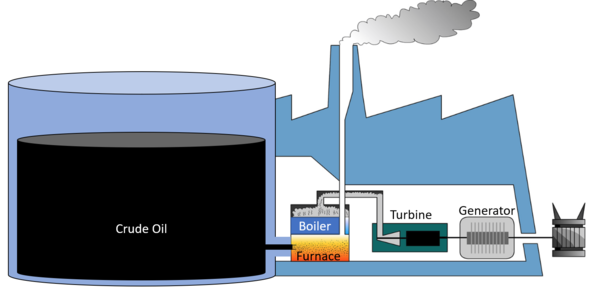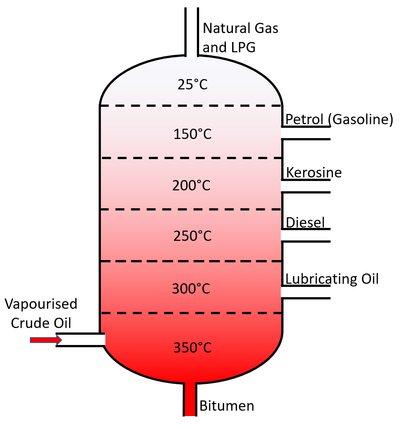Difference between revisions of "Crude Oil"
(→About Crude Oil) |
(→About Crude Oil) |
||
| Line 50: | Line 50: | ||
{| class="wikitable" | {| class="wikitable" | ||
| + | |+ Crude Oil Fraction Applications | ||
|- | |- | ||
| style="height:20px; width:70px; text-align:center;" |'''Fraction''' | | style="height:20px; width:70px; text-align:center;" |'''Fraction''' | ||
| Line 93: | Line 94: | ||
{| class="wikitable" | {| class="wikitable" | ||
| + | |+Fractional Distillation Tower | ||
| + | |- | ||
| + | |[[File:FractionalDistillation.png|center|400px]] | ||
| + | | style="height:20px; width:200px; text-align:center;" |A [[diagram]] showing a [[Fractional Distillation|fractional distillation]] tower. | ||
| + | |} | ||
| + | |||
| + | |||
| + | {| class="wikitable" | ||
| + | |+ Crude Oil Fraction Properties | ||
|- | |- | ||
| style="height:20px; width:100px; text-align:center;" |'''Fraction''' | | style="height:20px; width:100px; text-align:center;" |'''Fraction''' | ||
Revision as of 11:14, 15 January 2019
Contents
Key Stage 3
Meaning
Crude Oil is a Fossil Fuel formed from the remains of dead sea creatures trapped in the sediment at the bottom of the sea.
About Crude Oil
- Crude Oil is a non-renewable energy resource.
- Crude Oil has energy in its chemical potential energy store which can be transferred into a thermal energy store by combustion.
Power
- Crude Oil can be used to provide power directly buy burning it in homes, cars, trains. planes and in furnaces or it can provide power by generating electricity.
| A diagram of an oil power station. |
- 1. Crude Oil is burned in a furnace.
- 2. Water is heated in a boiler by the burning oil.
- 3. Water turns to steam and passes down pipes to turn a turbine.
- 4. The turbine causes a generator to spin.
- 5. The generator makes an electrical current.
Advantages
- Can work continuously.
- Power supply can be varied depending on demand.
- Few power stations needed to supply a large number of houses.
Disadvantages
- Cost of fuel.
- Produce Carbon Dioxide contributing to global warming.
- Other pollutants produced which can harm health or produce acid rain.
- Crude Oil will run out.
Key Stage 4
Meaning
Crude oil is a mixture of different hydrocarbons formed over millions of years from the remains of dead sea creatures trapped in the sediment at the bottom of the sea.
About Crude Oil
- Crude oil is known as a Fossil Fuel.
- Crude oil is a non-renewable energy resource so once it is used it cannot be replaced within our lifetime.
- Modern technology relies heavily on crude oil as both a fuel and a feedstock for producing plastics.
Crude oil can be separated by fractional distillation into different 'fractions' which have different applications:
| Fraction | Carbon Chain Length | Boiling Point (°C) | Application |
| Natural Gas | 1-2 | -160 to -89 | Fuel for heating homes and gas power stations. |
| LPG | 3-4 | -42 to -1 | Fuel for heating homes and gas power stations. |
| Petrol (Gasoline) | 5-10 | 20 to 200 | Fuel for cars and feedstock for plastic manufacture. |
| Kerosine | 10-16 | 180 to 260 | Fuel for Planes. |
| Diesel | 14-20 | 260 to 340 | Fuel for cars, trucks and trains. |
| Lubricating Oil | 20-50 | 370 to 600 | Lubrication for machines. |
| Bitumen | 70+ | Not distilled. | Tar for roads. |
| A diagram showing a fractional distillation tower. |
| Fraction | Natural Gas | LPG | Petrol | Kerosene | Diesel | Lubricating Oil | Bitumen |
| Carbon Chain Length | 1-2 | 3-4 | 5-10 | 10-16 | 14-20 | 20-50 | 70+ |
| Boiling Point | |||||||
| Viscosity | |||||||
| Flammability | |||||||
| Volatility | |||||||





